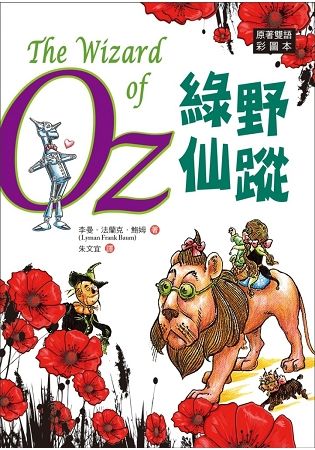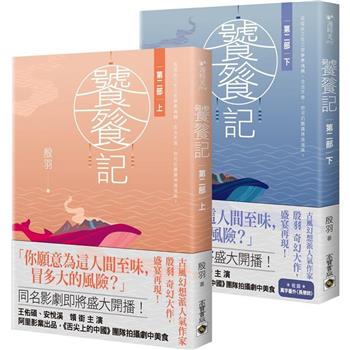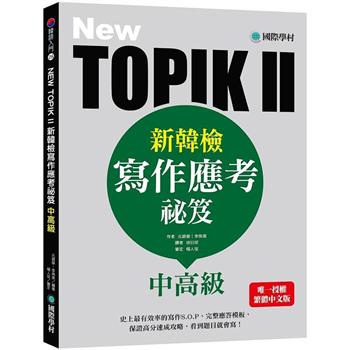1900年,《綠野仙蹤》(The Wonderful Wizard of Oz)在芝加哥出版問世,獲得廣大迴響。兩年後,被改編成百老匯舞台劇,亦大獲成功。作家鮑姆(L. Frank Baum, 1856–1919)遂於隔年開始陸續出版續作,在二十年間,一共創作了十四本系列故事。鮑姆辭世之後,由女作家Ruth P. Thompson接棒創作,另外也有其他作家的個別創作,於是講述奧茲國故事的創作,至少多達四十餘本。
《綠野仙蹤》被翻譯成各種語言,廣被改編成舞台劇、電影、動畫等。作者秉持著寫作「現代童話」的信念,希望降低童話故事的道德意味,給予孩子們歡樂時光與趣味的想像。因此創作出這本充滿想像力、情節詼諧卻不失純真的幻想故事。跟著桃樂絲一起冒險,與腦袋只有草的稻草人、沒有心的錫人、膽小怯懦的獅子邂逅,學習如何在困境與艱難中,堅持自己的夢想,最後面對自己的缺陷,尋回內心遺失的一角。
本書為《綠野仙蹤》的完整故事版本,採用英漢雙語編排,並穿插原著彩色插圖,不論是文學欣賞或是英語閱讀,都是最佳讀本。
| FindBook |
有 11 項符合
綠野仙蹤 The Wizard of Oz【原著雙語彩圖本】(25K彩色)的圖書 |
 |
綠野仙蹤 The Wizard of Oz【原著雙語彩圖本】(25K彩色) 作者:Lyman Frank Baum / 譯者:朱文宜 出版社:寂天文化事業股份有限公司 出版日期:2018-03-16 語言:繁體書 |
| 圖書選購 |
| 圖書館借閱 |
| 國家圖書館 | 全國圖書書目資訊網 | 國立公共資訊圖書館 | 電子書服務平台 | MetaCat 跨館整合查詢 |
| 臺北市立圖書館 | 新北市立圖書館 | 基隆市公共圖書館 | 桃園市立圖書館 | 新竹縣公共圖書館 |
| 苗栗縣立圖書館 | 臺中市立圖書館 | 彰化縣公共圖書館 | 南投縣文化局 | 雲林縣公共圖書館 |
| 嘉義縣圖書館 | 臺南市立圖書館 | 高雄市立圖書館 | 屏東縣公共圖書館 | 宜蘭縣公共圖書館 |
| 花蓮縣文化局 | 臺東縣文化處 |
|
|
圖書介紹 - 資料來源:博客來 評分:
圖書名稱:綠野仙蹤 The Wizard of Oz【原著雙語彩圖本】(25K彩色)
內容簡介
作者介紹
作者簡介
李曼•法蘭克•鮑姆(L. Frank Baum, 1856–1919)
鮑姆是美國作家,也是一位演員、報紙編輯,並曾任獨立電影的監製。
第一本童話著作是《鵝媽媽故事集》(Mother Goose in Prose),三年後出版了《綠野仙蹤》(The Wonderful Wizard of Oz),這本書讓他揚名立萬,之後又陸續創作了14本奧茲國系列作品,一生約創作了約50本著作。
包姆又被譽為當代童書世界的安徒生和格林兄弟,正如他在自序中所言,他要創造的是一個沒有以血腥恐怖傳達教化意味、只有歡笑愉悅的世界。
他曾說:「我的書,是為那些有年輕心靈的人們而寫,不論他們的實際年齡為何。」而我們也看到,他的故事是如何在世界各地為人所喜愛、所傳頌著。
李曼•法蘭克•鮑姆(L. Frank Baum, 1856–1919)
鮑姆是美國作家,也是一位演員、報紙編輯,並曾任獨立電影的監製。
第一本童話著作是《鵝媽媽故事集》(Mother Goose in Prose),三年後出版了《綠野仙蹤》(The Wonderful Wizard of Oz),這本書讓他揚名立萬,之後又陸續創作了14本奧茲國系列作品,一生約創作了約50本著作。
包姆又被譽為當代童書世界的安徒生和格林兄弟,正如他在自序中所言,他要創造的是一個沒有以血腥恐怖傳達教化意味、只有歡笑愉悅的世界。
他曾說:「我的書,是為那些有年輕心靈的人們而寫,不論他們的實際年齡為何。」而我們也看到,他的故事是如何在世界各地為人所喜愛、所傳頌著。
目錄
英文版目錄
Chapter 1 The Cyclone
Chapter 2 The Council with the Munchkins
Chapter 3 How Dorothy Saved the Scarecrow
Chapter 4 The Road Through the Forest
Chapter 5 The Rescue of the Tin Woodman
Chapter 6 The Cowardly Lion
Chapter 7 The Journey to the Great Oz
Chapter 8 The Deadly Poppy Field
Chapter 9 The Queen of the Field Mice
Chapter 10 The Guardian of the Gate
Chapter 11 The Wonderful City of Oz
Chapter 12 The Search for the Wicked Witch
Chapter 13 The Rescue
Chapter 14 The Winged Monkeys
Chapter 15 The Discovery of Oz, the Terrible
Chapter 16 The Magic Art of the Great Humbug
Chapter 17 How the Balloon Was Launched
Chapter 18 Away to the South
Chapter 19 Attacked by the Fighting Trees
Chapter 20 The Dainty China Country
Chapter 21 The Lion Becomes the King of Beasts
Chapter 22 The Country of the Quadlings
Chapter 23 Glinda The Good Witch Grants Dorothy’s Wish
Chapter 24 Home Again
中文版目錄
Chapter 1 龍捲風
Chapter 2 遇見芒奇金的居民
Chapter 3 救出稻草人
Chapter 4 穿越森林的路
Chapter 5 拯救鐵錫樵夫
Chapter 6 膽小的獅子
Chapter 7 驚險的旅程
Chapter 8 致命的罌粟花田
Chapter 9 田鼠皇后
Chapter 10 大門守衛
Chapter 11 奧玆的翡翠城
Chapter 12 尋找邪惡女巫
Chapter 13 救援
Chapter 14 飛猴
Chapter 15 露出馬腳
Chapter 16 大騙子的魔法
Chapter 17 熱氣球怎麼起飛的
Chapter 18 前往南方
Chapter 19 樹林警察
Chapter 20 精緻的瓷器國
Chapter 21 獅子成為萬獸之王
Chapter 22 垮德林人的國度
Chapter 23 善良女巫葛琳達實現女孩的願望
Chapter 24 重返家園
Chapter 1 The Cyclone
Chapter 2 The Council with the Munchkins
Chapter 3 How Dorothy Saved the Scarecrow
Chapter 4 The Road Through the Forest
Chapter 5 The Rescue of the Tin Woodman
Chapter 6 The Cowardly Lion
Chapter 7 The Journey to the Great Oz
Chapter 8 The Deadly Poppy Field
Chapter 9 The Queen of the Field Mice
Chapter 10 The Guardian of the Gate
Chapter 11 The Wonderful City of Oz
Chapter 12 The Search for the Wicked Witch
Chapter 13 The Rescue
Chapter 14 The Winged Monkeys
Chapter 15 The Discovery of Oz, the Terrible
Chapter 16 The Magic Art of the Great Humbug
Chapter 17 How the Balloon Was Launched
Chapter 18 Away to the South
Chapter 19 Attacked by the Fighting Trees
Chapter 20 The Dainty China Country
Chapter 21 The Lion Becomes the King of Beasts
Chapter 22 The Country of the Quadlings
Chapter 23 Glinda The Good Witch Grants Dorothy’s Wish
Chapter 24 Home Again
中文版目錄
Chapter 1 龍捲風
Chapter 2 遇見芒奇金的居民
Chapter 3 救出稻草人
Chapter 4 穿越森林的路
Chapter 5 拯救鐵錫樵夫
Chapter 6 膽小的獅子
Chapter 7 驚險的旅程
Chapter 8 致命的罌粟花田
Chapter 9 田鼠皇后
Chapter 10 大門守衛
Chapter 11 奧玆的翡翠城
Chapter 12 尋找邪惡女巫
Chapter 13 救援
Chapter 14 飛猴
Chapter 15 露出馬腳
Chapter 16 大騙子的魔法
Chapter 17 熱氣球怎麼起飛的
Chapter 18 前往南方
Chapter 19 樹林警察
Chapter 20 精緻的瓷器國
Chapter 21 獅子成為萬獸之王
Chapter 22 垮德林人的國度
Chapter 23 善良女巫葛琳達實現女孩的願望
Chapter 24 重返家園
序
作者序言
民間傳奇和神話故事伴隨著孩子們走過童年,每個健康的孩子,相信都對神奇有趣又虛幻的故事愛不釋手。就像格林童話和安徒生童話,帶給孩子的心靈許多歡笑,絕非其他作品可比。
然而,在兒童的圖書館中,代代相傳的老式童話已經被分類成「老故事」了,現在的「奇幻故事」已不再需要刻板印象中的精靈、侏儒和仙女。而且,以往的童話作者為了在童話中達到教化目的,所設計的血腥駭人故事,現在也已經不適用了。因為現代教育已經納入道德倫理,兒童想從神奇的童話故事中得到的是趣味,而不樂見令人感到不適的情節。
有了這樣的想法,我寫了《綠野仙蹤》這本書來取悅現代的兒童。我想讓這本書成為一種現代童話,讓孩子們能在這本書中獲得趣味與喜悅,不會感到憂傷或留下夢魘。
法蘭克.巴姆
一九○○年四月於芝加哥
*****
Folklore, legends, myths and fairy tales have followed childhood through the ages, for every healthy youngster has a wholesome and instinctive love for stories fantastic, marvelous and manifestly unreal. The winged fairies of Grimm and Andersen have brought more happiness to childish hearts than all other human creations.
Yet the old-time fairy tale, having served for generations, may now be classed as “historical” in the children’s library; for the time has come for a series of newer “wonder tales” in which the stereotyped genie, dwarf and fairy are eliminated, together with all the horrible and blood-curdling incidents devised by their authors to point a fearsome moral to each tale. Modern education includes morality; therefore the modern child seeks only entertainment in its wonder tales and gladly dispenses with all disagreeable incident.
Having this thought in mind, the story of “The Wonderful Wizard of Oz” was written solely to please children of today. It aspires to being a modernized fairy tale, in which the wonderment and joy are retained and the heartaches and nightmares are left out.
民間傳奇和神話故事伴隨著孩子們走過童年,每個健康的孩子,相信都對神奇有趣又虛幻的故事愛不釋手。就像格林童話和安徒生童話,帶給孩子的心靈許多歡笑,絕非其他作品可比。
然而,在兒童的圖書館中,代代相傳的老式童話已經被分類成「老故事」了,現在的「奇幻故事」已不再需要刻板印象中的精靈、侏儒和仙女。而且,以往的童話作者為了在童話中達到教化目的,所設計的血腥駭人故事,現在也已經不適用了。因為現代教育已經納入道德倫理,兒童想從神奇的童話故事中得到的是趣味,而不樂見令人感到不適的情節。
有了這樣的想法,我寫了《綠野仙蹤》這本書來取悅現代的兒童。我想讓這本書成為一種現代童話,讓孩子們能在這本書中獲得趣味與喜悅,不會感到憂傷或留下夢魘。
法蘭克.巴姆
一九○○年四月於芝加哥
*****
Folklore, legends, myths and fairy tales have followed childhood through the ages, for every healthy youngster has a wholesome and instinctive love for stories fantastic, marvelous and manifestly unreal. The winged fairies of Grimm and Andersen have brought more happiness to childish hearts than all other human creations.
Yet the old-time fairy tale, having served for generations, may now be classed as “historical” in the children’s library; for the time has come for a series of newer “wonder tales” in which the stereotyped genie, dwarf and fairy are eliminated, together with all the horrible and blood-curdling incidents devised by their authors to point a fearsome moral to each tale. Modern education includes morality; therefore the modern child seeks only entertainment in its wonder tales and gladly dispenses with all disagreeable incident.
Having this thought in mind, the story of “The Wonderful Wizard of Oz” was written solely to please children of today. It aspires to being a modernized fairy tale, in which the wonderment and joy are retained and the heartaches and nightmares are left out.
L. Frank Baum (Chicago, April, 1900)
|











